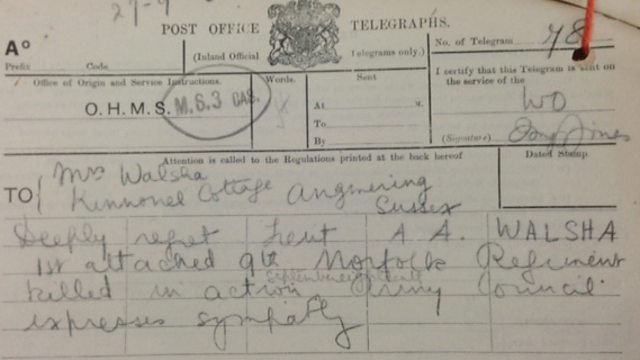Imjin Barracks, Gloucester: The Dreaded Telegram
Lessons that led to dramatic changes in how soldiers’ families were told of their death
In the mass battles of World War One there were large numbers of deaths and, in many cases, they were in places where their bodies couldn’t be recovered. There was also inexact information about deaths. What relatives were told was often very basic, to the effect that they had been killed, they were missing in action or they were presumed dead. It was usually in the form of a telegram (depending on rank) and hand delivered by someone like a policeman who would bring the information to the house.
The family may then eventually receive a letter explaining more about the circumstances of the death and the Imperial War Graves Commission would let them know whether their loved one had been buried and the location of the grave. After the news of the death of a loved one it was then left to the family and the local community to support each other.
The way relatives were informed of the death of a loved one during the Great War would vary depending on their rank. For officers the next of kin would often receive a telegram pre-printed in bold and handwritten in italic. There would have been different wording for wounded and missing. Sometimes non-pre-printed forms were used and it would be written by hand, reading:
Regret to inform you that Capt. J Smith Gloucester Regt. died of wounds 24 July. Lord Kitchener [or the Army Council, post 1915] expresses his sympathy.
Other ranks were usually notified by post, using Army Form B 104-82, though sometimes telegrams were used. If the serviceman was missing rather than known to be killed, Army Form B. 104-83 was used and if wounded it would be Army Form B 104-81. Where the location of a grave was known Army Form B 104-121 was sent later. Next of kin would also sometimes (if circumstances permitted) be sent a death certificate and a report of the serviceman’s burial.
Commanding officers would also often write to the next of kin, as would army chaplains (attached to the unit, or perhaps to a hospital where the soldier died), and the friends of the dead serviceman. These would also usually follow the official notification, though sometimes they preceded it.
Sometimes, the next of kin would discover the death of a loved one when casualty lists were posted outside places like town halls especially if a family had moved or the War Office had a wrong address. Buckingham Palace also sent out telegrams of sympathy. These would arrive some days or weeks after the official notification.
It’s now the role of the Joint Casualty and Compassionate Centre at Imjin Barracks in Gloucestershire to deal with the death of a serving soldier. A team of people are on hand 24 hours a day to take the initial call from a unit. They will be given basic details and it is then their job to contact the relevant people needed to inform the family. Once all the relevant family members have been informed letters of condolence are sent from their Commanding Officers and in addition now the family will receive letters from senior politicians.
Anyone who dies in the armed forces is entitled to a military funded funeral. In addition if they die overseas they will now repatriate the body to the UK. The Military will also offer to mark their grave with a military pattern headstone. Following the funeral the family will then be offered further help and support if necessary.
Location: Imjin Barracks, Innsworth, Gloucester GL3 1HW
Image: A telegram was often all a family would receive to tell them that their loved one had been killed in the war
Duration:
This clip is from
Featured in...
![]()
91�ȱ� Radio Gloucestershire—World War One At 91�ȱ�
Places in Gloucestershire that tell a story of World War One
![]()
Memory—World War One At 91�ȱ�
Memorials and the commemoration of wartime lives
![]()
91�ȱ� Front Life—World War One At 91�ȱ�
Everyday life in the towns, villages and countryside
More clips from World War One At 91�ȱ�
-
![]()
The loss of HMY Iolaire
Duration: 18:52
-
![]()
Scotland, Slamannan and the Argylls
Duration: 07:55
-
![]()
Scotland Museum of Edinburgh mourning dress
Duration: 06:17
-
![]()
Scotland Montrose 'GI Brides'
Duration: 06:41







